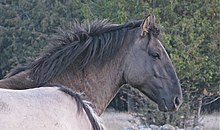Sorraia
| Traits | |
|---|---|
| Distinguishing features | Lean, leggy conformation, good withers, slim neck, convex profile; grulla or dun, typically without white markings |
The Sorraia is a rare
Members of the breed are small, but hardy and well-adapted to harsh conditions. They were occasionally captured and used by native farmers for centuries, and a remnant population of these nearly
Characteristics

The Sorraia breed stands between 14.1 and 14.3
On adult horses, the lay of the hair can create the appearance of stars and flags on the neck and chest. Also due to the lay of the hair, newborn foals can appear to have stripes all over, reminiscent of zebra stripes. The breed standard refers to this as "hair stroke".[4]

Color
Sorraia are generally
Genetics
The relationship between the Sorraia and other
Multiple authors have suggested that the Sorraia might be a descendant of the Tarpan based on shared morphological features, principally the typical color of its coat.[2][3][17] Other authors simply state that the Sorraia has "evident primitive characteristics", although they do not refer to a specific ancestor.[5] However, there have been no genetic studies comparing the Sorraia with the Tarpan, and similarity of external morphology is an unreliable measure of relatedness.[11]
Genetic studies to date have been inconclusive about the closest relative of the Sorraia. On one hand, studies using mitochondrial DNA showed a relationship with the
History
Although it is known that the Sorraia developed in the southern part of the Iberian peninsula,
Otherwise, the Sorraia breed was lost to history until 1920, when Portuguese zoologist and paleontologist Dr. Ruy d'Andrade first encountered the Sorraia horse during a hunting trip in the Portuguese lowlands. This remnant herd of primitive horses had continued to live a wild existence in these lowlands, which were rather inaccessible and had been used as a hunting preserve by Portuguese royalty until the early 1900s.
In the 1920s and 1930s, as mechanization became more prevalent, both wild and domesticated breeding stock diminished to almost nothing, and d'Andrade, along with his son Fernando, encouraged the conservation of the breed.[17] In 1937, d'Andrade began a small herd of his own with five stallions and seven mares from horses obtained near Coruche, Portugal. All Sorraias currently in captivity descend from these original horses obtained by d'Andrade, and it is believed that the remnant wild herds of the breed died out soon after.[12][23] These horses were kept in a habitat similar to their native one.[17] In 1975, two other farms took up the Sorraia's cause and acquired small herds to help with conservation. In 1976, three stallions and three mares were imported to Germany from Portugal to begin a sub-population there.[5] In March 2004, a small breeding herd of Sorraia horses was released on the estate of a private land owner who dedicated a portion of his property so that these horses could live completely wild, as did their ancestors. The refuge created for them is in the Vale de Zebro region of south western Portugal, one of places so named because this is where the Sorraia's predecessors dwelt.[24] Today, the breed is nearly extinct, with fewer than 200 horses existing as of 2007, including around 80 breeding mares. The Food and Agriculture Organization considers it to be maintaining critical risk status. The first studbook was published in 2004, dedicated to maintaining a written record of the bloodlines of the Sorraia.[23] Sorraias are present mainly in Portugal,[11] with a small population in Germany.[2] While not bred for a specific use, the Sorraia horses are versatile and have been used in herding bulls, dressage riding and light harness.[24]
American preservation efforts
Two Sorraia stallions were imported to the United States in the early 21st century. In 2006, another Sorraia stallion was imported to Canada where a Sorraia Mustang Preserve has been established on
Naming
Dr. Ruy d'Andrade gave the breed their name of "Sorraia".[21] D'Andrade took the name from the Sorraia River in Portugal.[3] The breed had previously been known by the local Portuguese as "zebro" or "zebra", due to their markings.[24] In the time of Christopher Columbus, the Sorraia was also known as the Marismeño,[26] but the Sorraia and the Marismeño have evolved into two different breeds over time. Today, the name Marismeño refers to a population of semiferal horses living in Doñana Natural Park in Spain.[11]
References
- ISBN 978-972-8387-20-4.
- ^ ISBN 978-0-8061-3884-8.
- ^ ISBN 978-0-671-66068-0.
- ^ a b c d Oelke, Hardy. "Sorraia Characteristics:SMS Standard of Perfection". Sorraia Mustang Studbook. Hardy Oelke. Retrieved 2011-10-30.
- ^ PMID 17404326.)
{{cite journal}}: CS1 maint: multiple names: authors list (link - ISBN 978-0-8138-0759-1.
- ^ "About the breed". Norwegian Fjord Horse Registry. Retrieved 2008-12-30.
- ^ ISBN 978-972-8387-20-4.
- ^ d'Andrade, R (1945). "Sorraia". Boletim Pecuário. 13: 1–13.
- ^ Jordana, J; Parés PM (1999). "Relaciones genéticas entre razas ibéricas de caballos utilizando caracteres morfológicos. Prototipos raciales" (PDF). AGRI. 26: 75–94. Archived from the original (PDF) on June 19, 2021.
- ^ PMID 16251517.)
{{cite journal}}: CS1 maint: multiple names: authors list (link - ^ PMID 12130666.)
{{cite journal}}: CS1 maint: multiple names: authors list (link - ^ .
- ^ S2CID 6595134.
- PMID 17177696.)
{{cite journal}}: CS1 maint: multiple names: authors list (link - ^ a b c d "Sorraia". Breeds of Livestock. Oklahoma State University. Retrieved 2008-12-11.
- ^ ISBN 978-1-56458-614-8.
- ^ Aberle, Kerstin S.; Ottamar Distl (2004). "Domestication of the horse: results based on microsatellite and mitochondrial DNA markers". Arch. Tierz., Dummerstorf. 6: 517–535.
- ISBN 978-0-85131-422-8.
- ISBN 978-0-85131-867-7.
- ^ a b Oelke, Hardy. "The Sorraia Horse". Equiworld. Archived from the original on May 6, 2008. Retrieved 2008-12-11.
- ISBN 978-972-8387-20-4.
- ^ )
- ^ a b c d Oelke, Hardy. "The Sorraia Horse, General Information". Sorraia Folheto Informativo. Retrieved 2011-10-30.
- ^ "American Sorraia Mustang Project". Windcross Conservancy. Retrieved 2011-01-08.
- ISBN 978-3-89118-096-9.
External links
